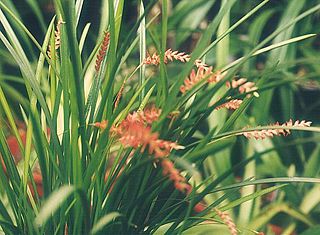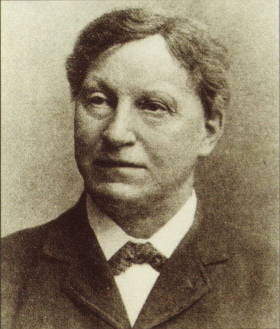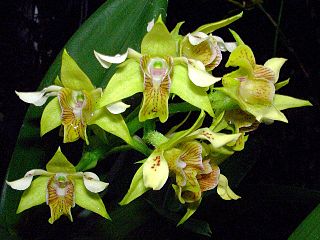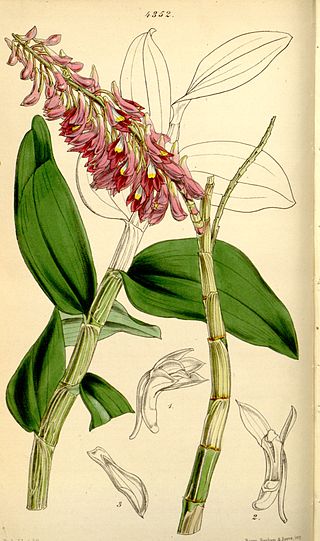
Dendrobium is a genus of mostly epiphytic and lithophytic orchids in the family Orchidaceae. It is a very large genus, containing more than 1,800 species that are found in diverse habitats throughout much of south, east and southeast Asia, including China, Japan, India, the Philippines, Indonesia, Australia, New Guinea, Vietnam and many of the islands of the Pacific. Orchids in this genus have roots that creep over the surface of trees or rocks, rarely having their roots in soil. Up to six leaves develop in a tuft at the tip of a shoot and from one to a large number of flowers are arranged along an unbranched flowering stem. Several attempts have been made to separate Dendrobium into smaller genera, but most have not been accepted by the World Checklist of Selected Plant Families.

Dendrochilum was a genus of epiphytic, lithophytic and a few terrestrial flowering plants in the orchid family (Orchidaceae). It is now considered to be a synonym of Coelogyne Lindl. The name of this genus was derived from Ancient Greek words dendron ("tree"), and either cheilos ("lip") or chilos, alluding to either the flowers' large lip or to their epiphytic growth. These orchids are popular among orchid collectors.

Johannes Jacobus Smith was a Dutch botanist who, between years 1905 to 1924, crossed the islands of the Dutch East Indies, collecting specimens of plants and describing and cataloguing the flora of these islands. The standard botanical author abbreviation J.J.Sm. is applied to plants described by J.J. Smith.
Datuk Anthony L. Lamb, P.G.D.K. was a British botanist, born in British Ceylon, who specialised in the flora of Sabah, East Malaysia, at the northern end of the island of Borneo.

Frederick William Thomas Burbidge (1847–1905) was a British explorer who collected many rare tropical plants for the famous Veitch Nurseries.

Dipodium, commonly known as hyacinth orchids, is a genus of about forty species of orchids native to tropical, subtropical and temperate regions of south-east Asia, New Guinea, the Pacific Islands and Australia. It includes both terrestrial and climbing species, some with leaves and some leafless, but all with large, often colourful flowers on tall flowering stems. It is the only genus of its alliance, Dipodium.

Chelonistele is a genus of the orchid family consisting of 13 currently accepted species. It is native to Indonesia, Malaysia and the Philippines. The plant grows as an epiphytic or lithophytic orchid.

Dendrobium anosmum, commonly known as the unscented dendrobium, is a species of epiphytic orchid with large purple flowers. It is widespread across Southeast Asia from Sri Lanka to New Guinea, including Indochina, Indonesia, the Philippines, etc. Despite its common name and scientific name, D. anosmum usually has a strong fragrance reminiscent of raspberries.

Dendrobium capra, also known as Dendrobium capra J.J. Smith, is a species of orchid endemic to the island of Java in Indonesia. It was described by Dutch botanist Johannes Jacobus Smith in 1910.

Dendrobium compressum is a species of orchid. It is native to Thailand, Malaysia, Myanmar, Borneo, Java, and Sumatra.
Dendrobium platycaulon is a species of orchid native to Borneo and the Philippines.

Dendrobium hasseltii, commonly known as the Hasselt's dendrobium or spinach orchid, is a species of orchid. It is native to Borneo, Java, Sumatra, and Peninsular Malaysia.

Dendrobium macrophyllum, commonly known as the large-leaved dendrobium or pastor's orchid, is a species of Orchid.

Dendrobium sanguinolentum, the blood-stained dendrobium, is a species of flowering plant in the family Orchidaceae. It is native to Southeast Asia.

Dendrobium secundum, also known as the toothbrush orchid, is a species of flowering plant in the genus Dendrobium of the family Orchidaceae. The common name refers to the fact that all the flowers are on the same side of the stem, much like the bristles all on one side of a toothbrush.

Cymboglossum, synonym Ascidieria, is a genus of flowering plants from the orchid family, Orchidaceae. It is native to Borneo, the Philippines, Sulawesi and Sumatra.

Cleisocentron is a genus of flowering plants from the orchid family, Orchidaceae. It has a disjunct distribution, known from the Himalayas, Vietnam, China and Borneo.

Microsaccus is a genus of flowering plants from the orchid family, Orchidaceae. It is native to Southeast Asia.

Dendrobium uniflorum is a species of flowering plant in the family Orchidaceae. It is native to the Malesia and Southeast Asia regions, in Thailand, Vietnam, Malaysia, Philippines, Borneo, Sulawesi, Sumatra.

Dendrobium plicatile is an Asian orchid species, a member of the genus Dendobium. It was formerly described as Flickingeria fimbriata.
















